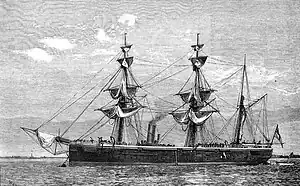 HMS Doterel | |
| Class overview | |
|---|---|
| Name | Doterel-class sloop |
| Operators | |
| Cost | Between £48,700 (Miranda) and £52470 (Gannet) |
| Built | 1878–1880 |
| In commission | 1879–1921 |
| Completed | 9 |
| Lost | 2 |
| Preserved | 1 (Gannet) |
| General characteristics [1] | |
| Type | Screw composite sloop |
| Displacement | 1,130 tons |
| Length | 170 ft (52 m) pp |
| Beam | 36 ft (11 m) |
| Draught | 15 ft 9 in (4.80 m) |
| Installed power | 900 to 1,128 indicated horsepower (671 to 841 kW) |
| Propulsion |
|
| Sail plan | Barque rigged |
| Speed | 11+1⁄2 knots (21.3 km/h) |
| Range | 1,480 nmi (2,740 km) at 10 kn (19 km/h) from 150 tons of coal |
| Complement | 140-150 |
| Armament |
|

The Doterel class was a Royal Navy class of screw-driven sloops. They were of composite construction, with wooden hulls over an iron frame. They were a revised version of an 1874 design by the Royal Navy's Chief Constructor, William Henry White, the Osprey-class sloop. Two of the class were lost, one to an explosion off Chile and one wrecked off Canada. Gannet is preserved at Chatham Historic Dockyard.
Design
The Nathaniel Barnaby design was a development of William Henry White's 1874 Osprey-class sloop. The graceful clipper bow of the Opsreys was replaced by a vertical stem and the engines were more powerful. They were of composite construction, with wooden hulls over an iron frame.
Propulsion
Power was provided by three cylindrical boilers, which supplied steam at 60 pounds per square inch (410 kPa) to a two-cylinder horizontal compound-expansion steam engine driving a single 13-foot-1-inch (3.99 m) screw. This arrangement produced 900 to 1,128 indicated horsepower (671 to 841 kW) and a top speed of between 11 and 11.6 knots (20.4 and 21.5 km/h).[1]
Armament
They were armed with two 7-inch (90cwt) muzzle-loading rifled guns on pivoting mounts, and four 64-pounder muzzle-loading rifled guns (two on pivoting mounts, and two broadside). Four machine guns and one light gun completed the weaponry.[1]
Sail plan
All the ships of the class were provided with a barque rig,[1] that is, square-rigged foremast and mainmast, and fore-and aft sails only on the mizzen mast.
Crew
They had a complement of approximately 140 men.[1]
Ships
| Name | Ship Builder | Laid down | Launched | Commissioned | Fate |
|---|---|---|---|---|---|
| Dragon | Devonport Dockyard | 26 April 1877 | 30 May 1878 | 19 February 1879 | Sold for breaking 24 September 1892 |
| Pegasus | Devonport Dockyard | 9 May 1877 | 13 June 1878 | 5 March 1879 | Sold for breaking 11 August 1892 |
| Gannet | Sheerness Dockyard | 1877 | 31 August 1878 | 17 April 1879 | Training ship 16 May 1903, renamed President, then in 1913 became training ship Mercury. In 1971 was turned over to the Maritime Trust, on display in Chatham Historic Dockyard |
| Phoenix | Devonport Dockyard | 8 July 1878 | 16 September 1879 | 20 April 1880 | Wrecked off Prince Edward Island, Canada on 12 September 1882 |
| Miranda | Devonport Dockyard | 8 July 1878 | 30 September 1879 | 22 July 1880 | Sold for breaking 24 September 1892 |
| Kingfisher | Sheerness Dockyard | 23 September 1878 | 16 December 1879 | 17 August 1880 | Training ship 10 November 1892, renamed Lark, then on 18 May 1893 training ship Cruiser. Sold in 1919 |
| Doterel | Chatham Dockyard | 13 May 1878 | 2 March 1880 | 7 December 1880 | Exploded by accident and sank off Punta Arenas, Chile on 26 April 1881, with loss of 143 men |
| Mutine | Devonport Dockyard | 7 June 1879 | 20 July 1880 | 10 May 1881 | Became boom defence vessel 1899, renamed HMS Azov in March 1904. Sold for breaking 25 August 1921 |
| Espiegle | Devonport Dockyard | 23 September 1879 | 3 August 1880 | 11 October 1881 | Became boom defence vessel 1899, renamed HMS Argo in March 1904. Sold for breaking 25 August 1921 |
Citations
References
- Winfield, R.; Lyon, D. (2004). The Sail and Steam Navy List: All the Ships of the Royal Navy 1815–1889. London: Chatham Publishing. ISBN 978-1-86176-032-6. OCLC 52620555.
- Preston, Antony; Major, John (2007). Send a Gunboat: The Victorian Navy and Supremacy at Sea, 1854–1904 (2nd ed.). London: Conway. ISBN 978-0-85177-923-2.